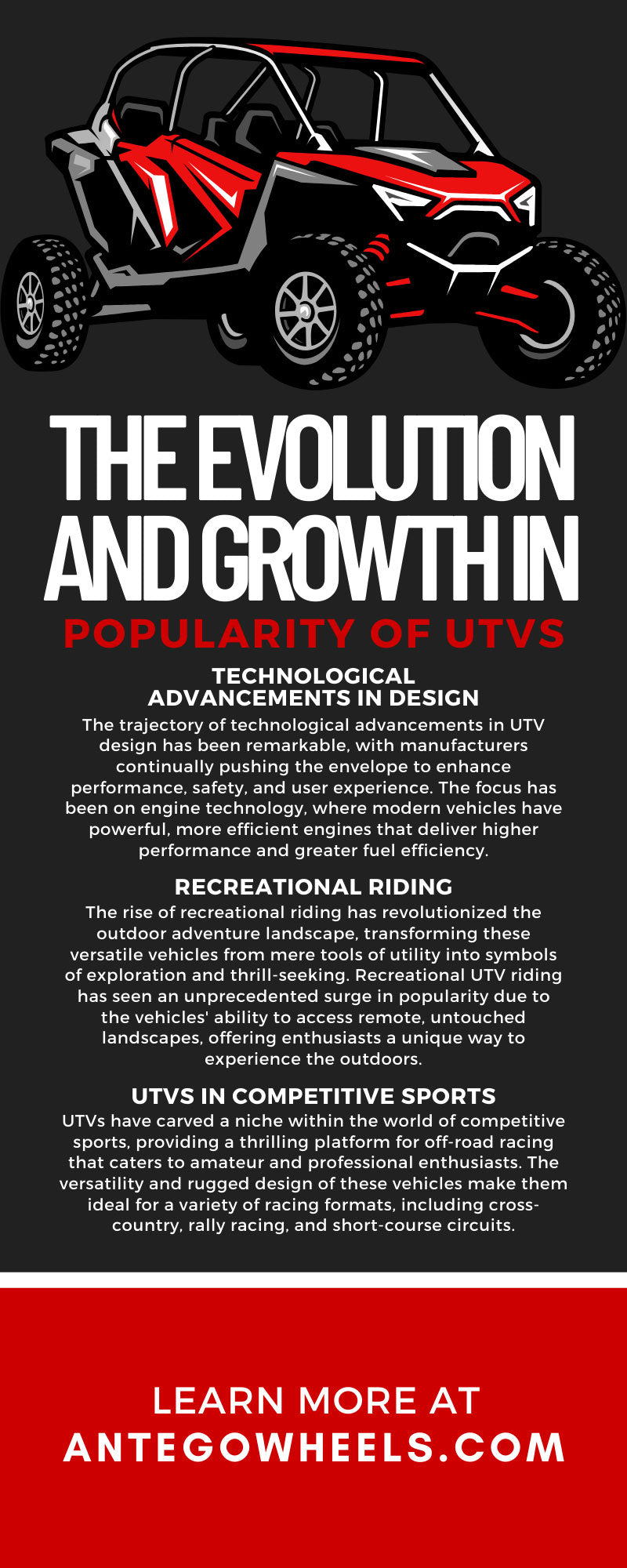It appears that your cart is currently empty
The Evolution and Growth in Popularity of UTVs
0 comments
The launch of utility terrain vehicles (UTVs) marked a revolutionary moment for both the agricultural sector and outdoor adventure enthusiasts. Today, they are popular not only for their robustness and reliability in challenging terrains but also for the sheer excitement and freedom they offer to thrill-seekers and nature lovers.
This rapid growth in popularity is a testament to their versatility and adaptability, making them capable of catering to a wide range of needs and desires. UTV innovation has expanded dramatically over the years, propelled by technological advancements and a growing community of users.
From simple, functional vehicles, UTVs have transformed into high-performance machines equipped with the latest technology and comfort-enhancing features. The evolution and growth in popularity of UTVs come mainly from enabling people to traverse previously inaccessible terrains and experience the outdoors in new and exciting ways.
The Origins of UTVs
The journey of utility terrain vehicles began in the early 20th century, but it wasn't until the mid-1960s that they became more popular. Early models were rudimentary in design, created with practicality in mind rather than comfort or speed. They could handle a variety of tasks in agricultural settings, such as transporting feed and equipment across the vast and often uneven landscapes of farms.
Their durability and ability to traverse rough terrain quickly made them invaluable to farmers and ranchers. Manufacturers soon recognized the potential of these versatile vehicles and began to innovate, gradually enhancing their design and capabilities. Despite their simplicity, they laid the groundwork for a market that would expand beyond agriculture into recreation and industrial applications.
UTVs vs. ATVs: Understanding the Difference
One of the most notable differences between UTVs and ATVs (all-terrain vehicles) lies in their design and intended use. UTVs, with their side-by-side seating arrangement, cater to a minimum of two passengers, providing a more communal experience. This contrasts sharply with ATVs, designed primarily for solo riders.
The seating configuration in UTVs not only allows for more passengers but also offers enhanced safety features such as roll cages, seat belts, and sometimes even doors and windshields. These features significantly contribute to a safer riding experience, especially in challenging terrain or during utility tasks.
Technological Advancements in Design
The trajectory of technological advancements in UTV design has been remarkable, with manufacturers continually pushing the envelope to enhance performance, safety, and user experience. The focus has been on engine technology, where modern vehicles have powerful, more efficient engines that deliver higher performance and greater fuel efficiency.
Safety features have seen significant improvements as well. Modern UTVs have advanced safety systems, like dynamic stability control and anti-lock braking systems (ABS), which contribute to making them safer to operate in varying environments.
Recreational Riding
The rise of recreational riding has revolutionized the outdoor adventure landscape, transforming these versatile vehicles from mere tools of utility into symbols of exploration and thrill-seeking. Recreational UTV riding has seen an unprecedented surge in popularity due to the vehicles' ability to access remote, untouched landscapes, offering enthusiasts a unique way to experience the outdoors.
With its side-by-side seating, the UTV promotes a shared adventure experience, making it an appealing choice for families and groups of friends seeking outdoor fun together.
Work and Industry
The UTV’s adaptability and ruggedness have made them an invaluable asset across a spectrum of industries, far beyond their roots in recreation and agriculture. In landscaping and property maintenance, UTVs streamline tasks such as transporting equipment, materials, and personnel across extensive grounds or rough terrain, proving indispensable for efficient operations.
Their versatility is an advantage for emergency services, particularly in areas difficult to access by traditional vehicles. Firefighting units, search and rescue teams, and police departments have integrated UTVs into their fleets to improve response times and effectiveness in challenging environments.
Customization and Aftermarket Enhancements
The aftermarket industry for UTV parts and accessories is vibrant, offering multiple products designed to enhance both the aesthetic appeal and functional capabilities of these vehicles. Among the most popular aftermarket enhancements are side-by-side wheel and tire packages—crucial for adapting a UTV to specific terrains, like sandy dunes, rocky trails, or muddy paths.
Other customization options include high-performance suspension systems tailored for aggressive off-roading, lighting upgrades, and protective accessories like skid plates and roll cages that safeguard the vehicle under harsh conditions.
Environmental Considerations
The environmental footprint of UTV riding has gathered increasing attention as the sport’s popularity surges, compelling users and manufacturers to seek sustainable practices actively. With growing environmental consciousness, the industry is evolving with a clear emphasis on minimizing ecological impacts.
Electric UTVs represent a significant leap towards sustainability, offering a cleaner alternative to their gasoline-powered counterparts. These electric models not only reduce emissions significantly but also produce less noise, thereby lessening the disturbance to wildlife and the natural environment during outdoor excursions.
UTVs in Competitive Sports
UTVs have carved a niche within the world of competitive sports, providing a thrilling platform for off-road racing that caters to amateur and professional enthusiasts. The versatility and rugged design of these vehicles make them ideal for a variety of racing formats, including cross-country, rally racing, and short-course circuits.
The competitive landscape has also been a crucible for innovation, driving manufacturers to refine and upgrade UTV models for peak performance. The demands of competitive racing directly influence enhancements in suspension systems, engine power, and durability.
The Future of UTVs
The future trajectory of utility terrain vehicles promises a mix of advanced technology, expanding market demand, and adaptable applications that transcend current expectations. The integration of AI and machine learning algorithms could lead to self-navigating UTVs, boosting their utility in recreational and industrial settings.
This evolution could improve tasks like precision agriculture or provide novel recreational experiences with smart, self-guided tours in natural parks and wilderness areas. This broadening scope of applications hints at a future where UTVs become indispensable in numerous fields, driven by continuous enhancements in functionality, sustainability, and performance.
The history and growth of UTVs, from niche utility vehicles to mainstream adventuring companions, is a testament to human ingenuity and the timeless pursuit of exploration. Whether enhancing a farm's efficiency or conquering sand dunes, the UTV has proven to be an indispensable tool and source of joy for many.
The evolution of UTVs promises even more exciting developments, ensuring that it remains a staple in outdoor lifestyles for years to come. The progression of these versatile vehicles mirrors the dynamic shifts in societal needs and leisure preferences, adapting to become more efficient, sustainable, and enjoyable for users worldwide.



0 comments